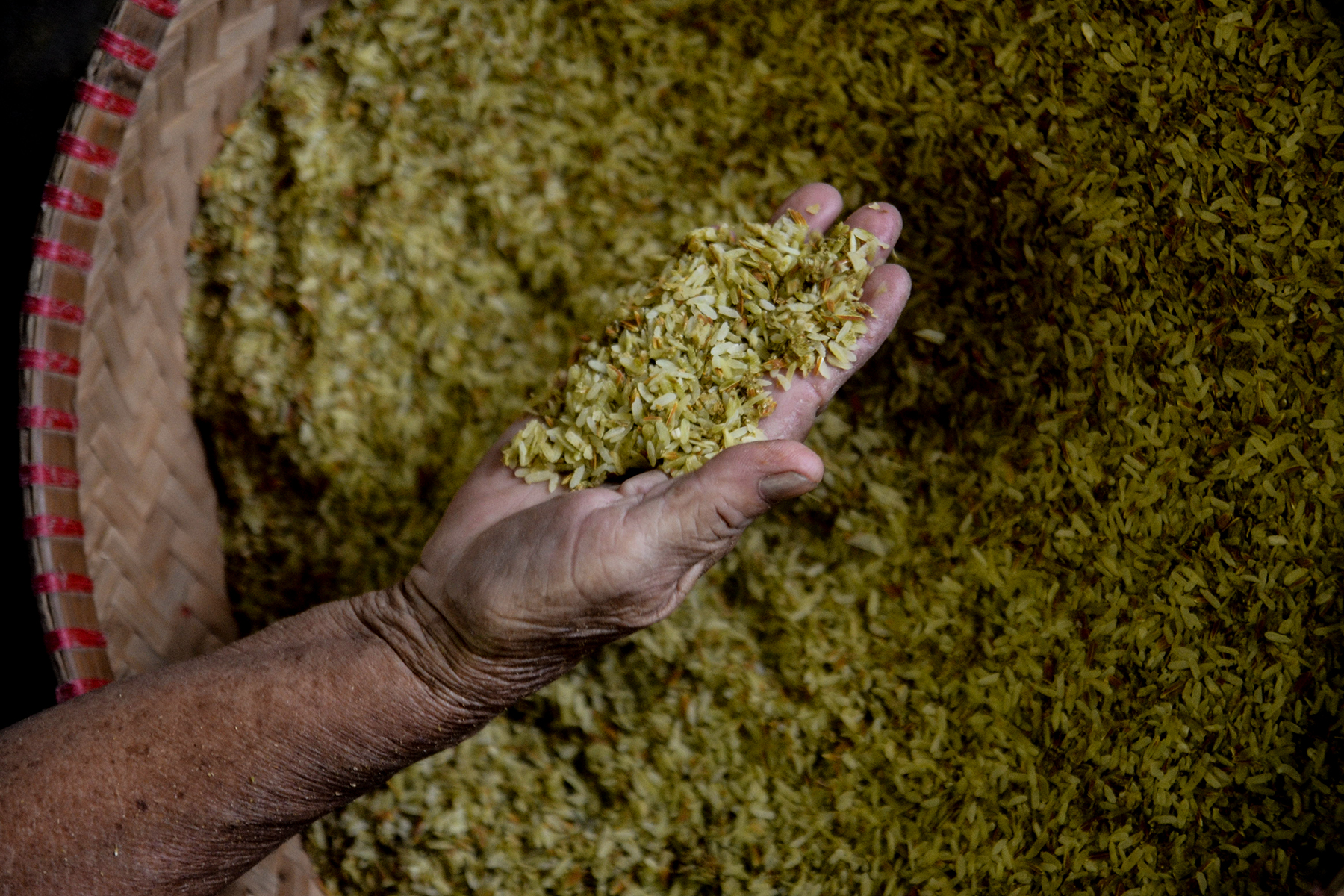Excerpt from the dossier, “Duman: The Lifeworld of Words”.
By Laya Boquiren-Gonzales, Phd
Duman refers to the processed seasonal heirloom rice variety or lacatan malutu that grows in contiguous municipalities in lower Pampanga, with a greater concentration in Santa Rita. Production is limited and seasonal, unlike high-yield and fast-growing rice varieties mass-produced for mass consumption in households, trading, and retail. It can only be harvested during cooler months once the locals feel the Northeast Monsoon, Hanging Amihan, or amyam that coincides with Christmas.
Production is a collective effort. Duman from the community of Santa Rita undergoes a meticulous process of iterative pounding and cooking, which results in minimal yield. For this reason, at least in popular discourse, duman can refer to both the grain and the processed green-gold product. However, according to the claim of stakeholders, this culinary product is distinctly associated with producers from family networks highly concentrated in Santa Rita, Pampanga.
Duman was mentioned and elaborately described by Fray Diego Bergaño (1695-1747), O.S.A in the Vocabulary of the Kapampangan Language in Spanish or the Bocabulario de Pampango en Romance y Diccionario de Romance en Pampango published in 1732 by Franciscans after the Augustinian press in Lubao, Pampanga was sold. This is the earliest citation on duman that the investigators examined for this Heritage Significance Assessment. The publication was reprinted later in 1860 as Vocabulario en la Lengua Pampanga. At the time of writing, from 1725 to 1731, Fray Bergaño was assigned to the Santa Monica Parish in Mexico, Pampanga. He was later transferred to Intramuros and became prior of the Augustinian office before he returned to Pampanga in 1747, where he passed away. Duman is an entry on page 185 of a version translated to English by Father Venancio Q. Samson, released in 2007 by the Center for Kapampangan Studies. The entry encompasses various connotations of duman:
Duman, (pp.) Noun refers to the glutinous rice grains nearing or about to mature. Neutral verb, or, Magduman, the rice grains arriving at that stage of development. Magduman also means to gather such grains, pound them, and make them into duman. P.3. past, Dimanan, such grains pounded and made into duman. Marumanduman, it is already near the stage where it could be made into duman.
Bergaño managed to capture some of the processes of pamagduman, which need to be correlated with the tools and access to visitas and their communities in Pampanga, Fray Diego Bergaño implemented a participatory approach, collecting words and their nuances in context.
Michael Forman has a nuanced description of the practice in a 1971 dictionary and supplies the term pamagduman. The term pamagduman denotes the production process or the entire social practice (88).
Du’man (V.) pounding rice [sometimes to the accompaniment of music]. cf. bayụ́ magduman, dumanan, makipagduman. (N.) pa:magduman.
In several interviews on television and social media before he passed away in 2022, Victor Galang, the patriarch of the Galang family producing duman, used the terms pamagduman and dumanan to refer to the production of duman. However, in most conversations with resource persons today, “duman” refers to the grain and the finished product.
The term magduruman refers to the practitioner or producer of duman, regardless of their role in production or gender.
The Northeast Monsoon or amyam signals the imminent harvest of duman. Once the cool winds are felt, the fields must be visited, and the panicles in each paddy dedicated for duman are inspected to ascertain readiness for harvest. The grains must be harvested within a few days (3-5) before it matures quickly. A few paddies at a time, magduruman set out for harvest early dawn, while stalks are heavy with dew before sunrise. Time is of the essence because duman cannot be exposed to the sun’s heat. “Tatanda ang duman kapag nabilad sa araw,” the producers would say. For this reason, duman must be harvested efficiently and immediately processed.
Locals can tell when duman is being processed because the fragrant aroma wafts in the air. Moreover, the sound of pounding and winnowing is often accompanied by music. Despite the arduous labor involved, it is a time of jubilation. Therefore, the Northeast Monsoon is a harbinger of the season for harvesting duman, and the community of practice and place are ready to receive the gifts of read more


